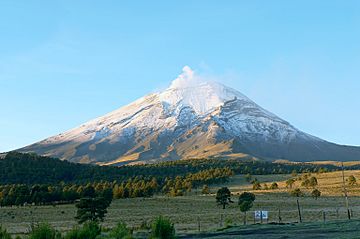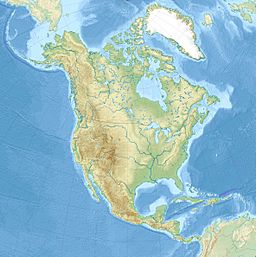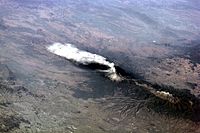Popocatépetl facts for kids
Quick facts for kids Popocatépetl |
|
|---|---|

Popocatépetl, viewed from the north from Paso de Cortés.
|
|
| Highest point | |
| Elevation | 5,426 m (17,802 ft) |
| Prominence | 3,020 m (9,910 ft) |
| Listing |
|
| Geography | |
| Location | Mexico-Puebla-Morelos, Mexico |
| Geology | |
| Mountain type | Stratovolcano |
| Last eruption | 2004 to 2021 (ongoing) |
| Climbing | |
| Easiest route | rock/snow climb |
Popocatépetl is a famous active stratovolcano in central Mexico. It is located in the states of Puebla, Morelos, and Mexico. This giant mountain is part of the Trans-Mexican Volcanic Belt.
At 5,426 meters (about 17,800 feet) tall, Popocatépetl is the second highest peak in Mexico. Only Citlaltépetl (Pico de Orizaba) is taller, at 5,636 meters (about 18,490 feet). Popocatépetl is connected to its "twin" volcano, Iztaccihuatl, by a high saddle of land called the "Paso de Cortés". The national park where both volcanoes are found is named Izta-Popo Zoquiapan National Park.
Popocatépetl is about 70 kilometers (43 miles) southeast of Mexico City. You can often see it from the city on clear days. Until recently, Popocatépetl had glaciers, just like Iztaccihuatl and Pico de Orizaba. But in the early 2000s, these glaciers melted away. This happened because of warmer temperatures and more volcanic activity.
The lava that erupts from Popocatépetl is usually a type called andesite. Sometimes, it also erupts dacite. The magma coming out now is often a mix of both.
Contents
Popocatépetl in Books and Art
Popocatépetl and Iztaccíhuatl are important in many stories and artworks.
- They are featured in Malcolm Lowry’s 1947 novel Under the Volcano. This book was also made into a movie in 1984.
- The legend of the two volcanoes is the main story in Duncan Tonatiuh’s book for young adults, The Princess and the Warrior: A Tale of Two Volcanoes.
Many artists have painted Popocatépetl:
- Marsden Hartley painted Popocatepetl, Spirited Morning-- Mexico in 1932. This painting is now at the Smithsonian American Art Museum.
- Dr. Atl included Popocatépetl in several of his works. These include his 1928 Self-Portrait with Popocatépetl and his 1942 The Shadow of Popo.
- Diego Rivera famously painted Popocatépetl in his 1904 oil painting The Threshing Floor (La era).
- The volcano also appears in a large mural by Juan Manuel Martinez Caltenco. This mural is in the Municipal Palace of Atlixco, Puebla.
- Jesús Helguera’s 1940 painting La Leyenda de los Volcanes shows the myth of Popocatépetl and Iztaccíhuatl.
What's in a Name?
The name Popocatépetl comes from the Nahuatl language. It combines the words popōca (meaning "it smokes") and tepētl (meaning "mountain"). So, Popocatépetl means Smoking Mountain.
Mexicans often call the volcano El Popo for short. Another nickname is Don Goyo. This name comes from a local legend. People say that an old man named Gregorio Chino Popocatépetl once met a villager on the mountain. Gregorio was the spirit of the volcano. He would talk to locals and warn them if an eruption was coming. Because of this story, people bring flowers and food to the volcano every March 12th. This day celebrates San Gregorio.
How Popocatépetl Was Formed
Popocatépetl is a stratovolcano, which means it's shaped like a cone with steep sides. It has a large, oval-shaped crater at the top. This crater is about 400 by 600 meters (1,300 by 2,000 feet) wide.
Scientists believe Popocatépetl is about 730,000 years old. Its base is about 25 kilometers (15 miles) wide. Over time, at least three older volcanoes in this area collapsed. This happened during huge debris avalanche events. The current Popocatépetl volcano grew south of an older cone called El Fraile.
Popocatépetl was quiet for about 50 years. But its activity increased in 1991. Since 1993, smoke has been coming out of its crater almost constantly. Scientists watch the volcano closely to keep people safe.
History of Eruptions
Popocatépetl is one of Mexico's most active and famous volcanoes. It has had more than 15 major eruptions since the Spanish arrived in 1519.
Important Eruptions Over Time
- First Century AD: A very powerful eruption around this time might have caused many people to move and settle in Teotihuacán.
- 1947: A major eruption occurred.
- December 21, 1994: The volcano started spewing gas and ash. The ash traveled about 25 kilometers (15 miles) away. This activity led to towns being evacuated and scientists starting to monitor the volcano very closely.
- December 2000: Thousands of people were moved to safety because scientists warned of a big eruption. The volcano then had its largest eruption in 1,200 years.
- December 25, 2005: The crater exploded, sending a large column of smoke and ash about 3 kilometers (10,000 feet) into the air. It also ejected lava.
- January and February 2012: Scientists noticed more volcanic activity. On January 25, an ash explosion covered the area in dust and ash.
- April 15, 2012: The volcano hurled superheated rock fragments into the air. Ash and water vapor plumes were seen 15 times in 24 hours.
- May 8, 2013: Popocatépetl erupted again with a strong tremor. Ash plumes rose 3 kilometers (10,000 feet) high. They drifted over villages like San Juan Tianguismanalco and the city of Puebla. Fiery volcanic rock fragments were thrown up to 700 meters (2,300 feet) from the crater.
- July 4, 2013: Several eruptions of steam and ash caused more than 40 flights to be canceled at Mexico City and Toluca airports.
- August–September 2014: Explosions continued, sending ash plumes up to 3,000 meters (10,000 feet) high. At night, a glow from the crater could often be seen.
- March 28, 2016: An ash column 2,000 meters (6,600 feet) high was released. A "security ring" of 12 kilometers (7.5 miles) was set up around the summit for safety.
- April 3, 2016: Popocatépetl erupted, spewing lava, ash, and rock.
- August 2016: Eruptions continued, with four separate blasts on August 17.
- November 10, 2017: Eruption continued.
- December 15, 2018: Spewed lava, ash, and rock.
- January 22, 2019: Spewed ash up to 4 kilometers (13,000 feet) high.
- March 19, 2019: Fragments of the volcano's dome were shot up to 1.5 kilometers (1 mile) away. Because of this, the warning level was raised to Yellow Phase 3 as a safety measure.
- June 3, 2019: Popocatépetl sent an ash column to about 11,000 meters (37,000 feet) above sea level.
- June 18, 2019: Ash clouds reached 8,500 meters (28,000 feet).
- June 24, 2019: Another massive ash cloud was sent several kilometers into the air.
- July 18, 2019: Popocatépetl erupted three times, sending ashes 1.5 kilometers (5,000 feet) into the air each time.
- July 20, 2019: Volcanic ash was reported in Xochimilco after a morning eruption.
- October 2019: The volcano erupted multiple times in one night.
- November 2019: An eruption caused a KLM flight from Amsterdam to Mexico City to turn back.
- January 9, 2020: Popocatépetl expelled lava and rock, sending ash clouds to 6,100 meters (20,000 feet).
- January 27, 2020: Popocatépetl erupted in a spectacular nighttime display of rock and ash.
Gallery
-
Seen from the International Space Station in February 2009
-
Seen from near the summit of Iztaccihuatl
Images for kids
See also
 In Spanish: Popocatépetl para niños
In Spanish: Popocatépetl para niños













